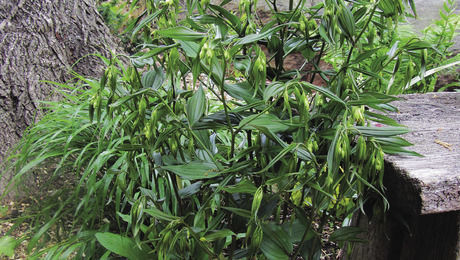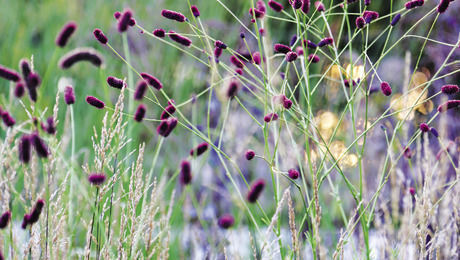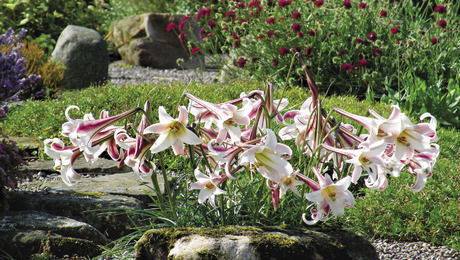
We have all seen it: the line of arborvitae (Thuja occidentalis and cvs., USDA Hardiness Zones 2–7) marching down the property line, stiff as can be, their heads lopped off because they have grown too tall. Or maybe it’s a boxwood hedge (Buxus spp. and cvs., Zones 6–9), overgrown and shaggy because nobody has the time to keep it trimmed. Plants are a fine alternative to walls and fences when it comes to creating privacy screening and defining boundaries, but the traditional line of conifers or a trimmed hedge can look uncomfortably stark and doesn’t offer much to look at for all the garden space it consumes.
Boundary plantings don’t have to be rigid or dull. Nor do they need to be high maintenance. Informal mixed plantings can define boundaries and create privacy as effectively as any formal hedge while offering a level of interest that a line of junipers (Juniperus spp. and cvs., Zones 2–9) or cypress (Cupressus spp. and cvs., Zones 6–10) just can’t match. Here are nine outstanding plants that provide color, distinctive form, and lively textures while screening or defining boundaries along a property line. Most are evergreens, and each offers multi-season interest. All are easily grown, adaptable, low-maintenance plants that won’t grow out of bounds or take over your neighbor’s property.
Variegated Italian buckthorn brightens partial shade
Name: Rhamnus alaternus ‘Argenteovariegata’

Zones: 7 to 9
Size: Up to 15 feet tall and 6 to 12 feet wide
Conditions: Full sun to partial shade; well-drained soil
Although amenable to clipping and shaping, variegated Italian buckthorn looks its best when allowed to fill out naturally into a billowing cloud of silver-streaked evergreen foliage. Its flowers are inconspicuous and the plants don’t set much fruit, but the fine-textured, frosty foliage is a godsend for lightening up coarse-textured, predominantly dark groupings of laurels (Laurus nobilis and cvs., Zones 8–11) or rhododendrons (Rhododendron spp. and cvs., Zones 5–9).
‘Arthur Menzies’ grape holly looks its best in winter
Name: Mahonia × media ‘Arthur Menzies’

Zones: 7 to 9
Size: 8 feet tall and 5 feet wide
Conditions: Full sun to partial shade; any well-drained soil; deer resistant
There aren’t many plants that save their best for winter, and among those few, ‘Arthur Menzies’ grape holly is a standout. Two-foot-long spikes of fragrant yellow blossoms explode like fireworks atop a ruff of tropical-looking evergreen foliage in January, followed by long chains of powdery blue berries that persist through spring. Whorls of bold-textured, deer-resistant compound leaves lining the upright trunks create an eye-catching pagoda-like habit. Much narrower than it is tall, ‘Arthur Menzies’ grape holly establishes a boundary without eating up excessive space.
Sun Stripe® pampas grass is less aggressive than its kin
Name: Cortaderia selloana* ‘Monvin’

Zones: 7 to 11
Size: 4 to 6 feet tall and wide
Conditions: Full sun; well-drained soil
More compact and colorful than the familiar towering pampas grass, the dwarf, gold-striped Sun Stripe® is still tall enough to provide privacy screening, while its fine texture and fountainlike outline stand in sharp contrast to conventional hedging materials. Feathery, 6-foot-tall blooms catch the autumn light, while the evergreen blades add lively color all year long. Sun Stripe® pampas grass is less vigorous and less likely to self-sow than ordinary pampas grass, which has become invasive in California and some southwestern states.
*This species might be considered aggressive or invasive in some areas. Please visit invasiveplantatlas.org for more information.
Darwin’s barberry is colorful year-round
Name: Berberis darwinii

Zones: 6 to 9
Size: 6 to 8 feet tall and 4 to 6 feet wide
Conditions: Full sun; well-drained soil; deer resistant
Sometimes a boundary planting needs to say, “Keep out!,” and the dense, thorny, and impenetrable Darwin’s barberry says so loud and clear while remaining colorful and attractive all year long. In early spring, the spiny evergreen foliage is festooned with clusters of bright orange flowers. These are followed in summer and fall by waxy blue-black berries. If that were not enough, the leaf tips often turn brilliant scarlet in winter, just when the landscape could use an extra festive touch. As a bonus for rural gardeners, Darwin’s barberry is unpalatable to deer.
Red-leaved rose attracts attention but no trespassers
Name: Rosa glauca

Zones: 2 to 8
Size: 6 to 8 feet tall and 5 to 7 feet wide
Conditions: Full sun; well-drained soil
Rose enthusiasts love red-leaved rose as a landscape specimen, but its upright habit and generous height suit it, as well, to screening or boundary plantings. Thorny enough to deter unwanted traffic and densely twiggy enough to provide some winter screening, red-leaved rose offers year-round interest with its dainty pink spring flowers; waxy purple-tinted foliage; and persistent, bright red autumn fruit.
‘Picturata’ Japanese laurel is a sure thing
Name: Aucuba japonica ‘Picturata’

Zones: 6 to 10
Size: 6 to 10 feet tall and wide
Conditions: Partial to full shade; tolerates a wide range of soils
Serious gardeners once derided Japanese laurel as an unfashionable dinosaur of a plant, but any shrub that tolerates poor growing conditions and deep shade as well as this deserves a second look. Eye-catching variegated selections, like ‘Picturata’, are helping Japanese laurel make a well-deserved comeback. Bold texture and bright gold–splotched evergreen foliage will light up a heavily shaded property line where few other shrubs will grow. If planted with a male-flowering cultivar, the female ‘Picturata’ will yield clusters of vivid red autumn berries.
‘Nymansay’ leatherwood is a slender tree that stays inbounds
Name: Eucryphia × nymansensis ‘Nymansay’

Zones: 8 to 10
Size: Up to 20 feet tall and 6 to 8 feet wide
Conditions: Full sun to partial shade; well-drained soil
If there’s room for a tree in your property-line planting, ‘Nymansay’ leatherwood should be a prime candidate. Dense, leathery evergreen foliage provides year-round screening, while an unusually slender habit ensures that this small tree will not grow out of bounds. Handsome as the leaves are, this leatherwood’s chief glory lies in its sweetly fragrant, 2-inch-wide flowers, which smother the plant in a blanket of white during July and August, when few other trees are in bloom.
Leatherleaf viburnum offers dense cover
Name: Viburnum rhytidophyllum and cvs.

Zones: 5 to 8
Size: 8 to 15 feet tall and 6 to 12 feet wide
Conditions: Full sun to partial shade; well-drained soil; deer resistant
Looking for a tall, handsome evergreen shrub as part of a shady property-line planting? The shade-loving, deer-resistant leatherleaf viburnum ought to fit the bill. Vibrant red berries in large flattened clusters glow in the shade during fall and winter, and long, shiny, deeply veined leaves contribute striking landscape texture all year round. Leatherleaf viburnum’s dark green color and mounding habit pair especially well with wispy fountains of clumping bamboo.
Fountain bamboo won’t terrorize the neighborhood
Name: Fargesia nitida and cvs.

Zones: 5 to 9
Size: 6 to 8 feet tall and wide
Conditions: Partial shade; well-drained soil
Many bamboos spread aggressively, with long questing rhizomes that break through paving, invade neighboring properties, and even penetrate into house walls. The well-mannered genus Fargesia offers an exception, with a self-contained clumping growth habit, which will keep you on good terms with your neighbors. Fountain bamboo is among the hardiest and most widely adapted of the genus, with slender golden stems and elegant, airy, light green foliage along its gently arching branches. This deer-resistant bamboo is dense enough for year-round privacy screening yet delicate enough in form and texture to contrast effectively with dense conifers and broad-leaved evergreens.
Two Plans for Privacy
When designing a mixed boundary planting, I like to set plants in a narrow zigzag pattern, rather than a straight line, using interlocking groups of three or five plants. Repeating groupings at intervals along the property line brings a sense of consistency and order to the design. Repeating plant groups at regular intervals establishes a more formal mood, while varied, random intervals feel more relaxed and naturalistic. Bold accent plants, like Sun Stripe® pampas grass, at or near the ends of a boundary planting serve as visual anchors.

A planting for all-season interest
From the blossoms of ‘Arthur Menzies’ grape holly in midwinter to the fruit of the red-leaved rose in autumn, this boundary planting, brimming with variegated evergreen foliage, entertains the eye in every season. A foreground planting of ‘Munstead’ lavender adds a finishing touch of summer color and fragrance.
Featured Plants:
1. Sun Stripe® pampas grass
2. ‘Nymansay’ leatherwood
3. Red-leaved rose
4. ‘Arthur Menzies’ grape holly
5. Variegated Italian buckthorn
6. Darwin’s barberry
Other Plants:
7. ‘Munstead’ lavender (Lavandula angustifolia ‘Munstead’, Zones 5–8)

A planting for shade
A shady boundary doesn’t need to be drab. Colorful foliage and bold contrasts of form and texture enliven this mixed boundary planting. ‘Bertram Anderson’ lungwort and variegated Gladwyn iris light up the base of the tall plants with their spotted and silver-striped leaves. ‘Moyer’s Red’ heavenly bamboo adds vivid red winter-foliage color.
Featured Plants:
1. Fountain bamboo
2. Leatherleaf viburnum
3. ‘Picturata’ Japanese laurel
Other Plants:
4. ‘Moyer’s Red’ heavenly bamboo (Nandina domestica* ‘Moyer’s Red’, Zones 6–11)
5. Goatsbeard (Aruncus dioicus, Zones 3–7)
6. ‘Bertram Anderson’ lungwort (Pulmonaria longifolia ‘Bertram Anderson’, Zones 3–8)
7. Variegated Gladwyn iris (Iris foetidissima ‘Variegata’, Zones 4–9)
Andrew Schulman is a garden designer in Seattle, Washington.
Illustrations: Elara Tanguy
The following mail-order plant sellers offer the widest selection of the plants featured:
- Forestfarm, Williams, Ore.; 541-846-7269; forestfarm.com
- Gossler Farms Nursery, Springfield, Ore.; 541-746-3922; gosslerfarms.com
Fine Gardening Recommended Products

A.M. Leonard Deluxe Soil Knife & Leather Sheath Combo
Fine Gardening receives a commission for items purchased through links on this site, including Amazon Associates and other affiliate advertising programs.

Pruning Simplified: A Step-by-Step Guide to 50 Popular Trees and Shrubs
Fine Gardening receives a commission for items purchased through links on this site, including Amazon Associates and other affiliate advertising programs.

Black and Decker 22-inch Cordless Hedge Trimmer
Fine Gardening receives a commission for items purchased through links on this site, including Amazon Associates and other affiliate advertising programs.
- 38 x 7 x 7 inches
- 6.9 pounds
- 1 Lithium Ion battery required (included)

















Comments
Log in or create an account to post a comment.
Sign up Log in